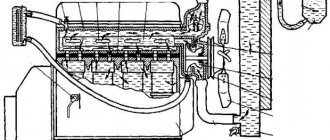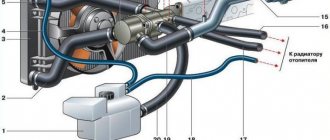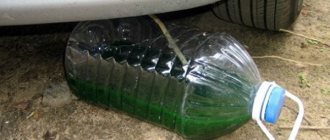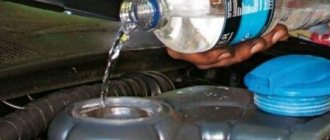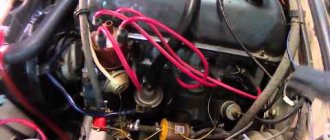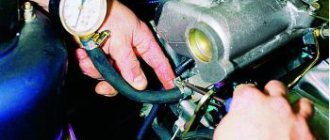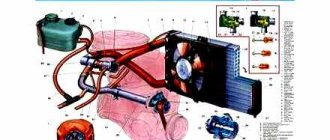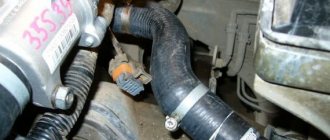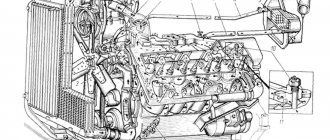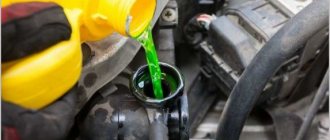The engine cooling system is designed to ensure that the power unit operates within a strictly defined temperature range. In other words, both overheating and too intense cooling of the motor, which does not allow the internal combustion engine to reach operating temperature, are allowed.
Next, we will talk about how to diagnose the engine cooling system, as well as what you should pay attention to if the engine does not reach operating temperature (remains cold) or overheats, there are coolant leaks, etc.
Read in this article
Engine cooling system diagnostics
It is not difficult to guess that the main task of the cooling system is first to ensure the speedy achievement of operating temperatures, after which further maintenance of this temperature and effective removal of excess heat into the atmosphere is realized.
At the same time, it is not allowed for the engine to remain too cold, since an engine that is not warmed up to operating temperatures wears out faster under load, and a very overheated internal combustion engine can seize.
The cooling system on modern cars is a combined type solution, that is, the engine is cooled by both liquid and air cooling. Taking into account the fact that this system includes a number of components, and that a special coolant (antifreeze or antifreeze) circulates in a closed circuit, malfunctions often occur during vehicle operation.
In practice, as part of diagnostics, it is necessary to check the entire system, and not just individual elements, for various defects or wear. It is also important to consider that modern cars often have very limited space under the hood.
This means that the cooling system hoses may have bends, several connection points, and differ in size and shape. Although the service life of hoses is quite long, even high-quality products wear out over time.
- So, let's get back to the diagnosis. First of all, you need to check the level and condition of the coolant in the expansion tank. It is recommended that the level be between the “min” and “max” marks on a warm internal combustion engine. On a cold engine, it is quite possible to reduce the level to o, since after the engine warms up, the level will increase as a result of the expansion of the hot coolant.
Also cloudiness of the coolant, presence of impurities, etc. usually indicates that antifreeze or antifreeze needs to be changed. As a rule, coolants are designed for 2-3 years of service, then a loss of useful properties occurs.
- Let's move on. If it is noticeable that the coolant level, even after being brought back to normal, is still dropping quite quickly, you should check the cooling system for leaks. All connections need to be inspected. As a rule, antifreeze leaks from:
- expansion tank;
- rubber hoses;
- pipes or pumps;
- thermostat;
- radiator;
The tank tends to crack, and its lid often becomes unusable. Also, leaks at the joints occur if the clamps become loose. The cooling radiator can also be damaged mechanically, cracks appear in it, etc. Coolant often leaks from under the thermostat housing; leaks can also be found in the area where the cooling system water pump is installed.
In any case, with the engine turned off, the tightness of the cooling system is determined by supplying air into the system. Also, instead of the radiator cap, a device is installed through which air is pumped to 100 kPa. A decrease in pressure will indicate depressurization.
- Now let's imagine that the system is sealed, the coolant condition is normal, the antifreeze does not leave, but the thermal operating conditions of the internal combustion engine are still disturbed. In such a situation, the motor may either overheat or not reach operating temperature.
Usually such problems are related to the thermostat. It can be quickly checked directly on the machine without removal. First, start the cold internal combustion engine, then let the engine run at idle. If the thermostat is normal, the lower radiator reservoir will also begin to heat up as the power plant warms up. This suggests that when the coolant heats up to 80–85 ºС, the thermostat is activated.
Problems also arise if the thermostat does not close when the coolant cools. This is manifested by a long warm-up of the internal combustion engine; the engine warms up, but only partially, or the engine remains cold all the time. These signs indicate that the thermostat is open all the time and the coolant is constantly circulating in a large circle through the radiator.
In both the first and second cases, the thermostat must either be changed immediately, or the device must be placed in a hot liquid, then its opening temperature must be measured and the operability of the element determined.
Cooling system malfunctions
The need to repair the cooling system arises in the event of constant overheating or undercooling of the coolant, a decrease in the level of coolant in the system as a result of a leak, the occurrence of electrolysis in the coolant, etc.
Overheating of the coolant causes engine detonation, which sharply increases wear on the cylinders and piston rings, leads to burnout of the pistons and reduced durability of the plain bearings (liners). Disruption of the combustion process of the fuel-air mixture during overheating and an increase in friction forces lead to an increase in fuel consumption and a decrease in engine power. A decrease in coolant temperature in the engine cooling jacket increases wear of CPG parts due to oil being washed away from the cylinder walls by fuel. The oil is diluted by fuel entering the oil sump, resulting in more intense formation of resin and varnish deposits on the pistons and piston rings.
A decrease in coolant temperature for every 10 °C from the nominal value reduces engine power by 1.5% and increases fuel consumption by 2%.
Engine overheating can be caused by: lack of coolant in the cooling system due to its leakage or boiling over, clogging of the system, breakage or slipping of the fan drive belt, failure of the electric or fluid coupling of the fan, jamming of the thermostat in the closed position or the blinds in the closed position, incorrect setting the ignition timing.
Engine overcooling is possible when the thermostat is stuck open or the thermostat itself is missing, or the hydraulic or electric fan drive is faulty.
One of the malfunctions of modern cooling systems with a radiator made of aluminum and a energized fan temperature sensor (thermal switch) is the occurrence of electrolysis.
Electrolysis is the reaction of decomposition of a solution of chemical substances when an electric current passes through them. Characteristic signs of electrolysis: clogging of the radiator tubes, the presence of white deposits near its leaky places and greenish deposits near the thermal switch. If such symptoms occur, you must carefully check the connections of the electrical devices of the cooling system.
For radiators made of aluminum, it is not recommended to use water as a coolant, as this will cause corrosion of the tubes.
Coolant leakage can be caused by leaking connections between cooling system hoses and fittings and pipes, leaking connections of pipe flanges, leaking drain plugs and heater taps, damage to hoses, cracks in tanks and the radiator core, and wear of the self-clamping seal of the liquid pump.
Useful tips
Please note that a decrease in the level of antifreeze or antifreeze does not always indicate problems with the cooling system. Coolant can go directly into the cylinders if there is damage to the cylinder head gasket, cracks in the head or block, etc.
In this situation, the engine often emits white smoke as the coolant escapes through the exhaust in the form of steam. In this case, the head or block must be removed; as part of the diagnosis, crimping of the block head is performed. Then a decision is made to repair the cylinder head or replace the element. Also, antifreeze or antifreeze may leak if problems arise with the engine block plugs. Leaks at the plugs will indicate that the engine plugs need to be replaced.
- It should also be added that with the onset of the cold season, it is very important not only to have coolant filled strictly to the level, but also to the density of the antifreeze. Remember, if you had to add distilled water during operation, the density of the solution decreases. In simple words, when the temperature drops, the liquid can freeze. Freezing often results in damage to both the cooling system elements and the internal combustion engine itself.
The coolant density is measured with a hydrometer; if necessary, the antifreeze concentration should be increased by adding concentrate. At the same time, mixing antifreeze and antifreeze of different brands is strongly not recommended.
It is also important to remember that coolant concentrate is a strong poison! Do not allow the substance to come into contact with your skin or eyes, and do not take it orally!
- Let us note once again that antifreezes or antifreezes based on ethylene glycol contain a package of active additives that prevent the formation of corrosion and have antioxidant and antifoaming properties. However, over time, the additives wear off and stop working.
As a result, the pump impeller is destroyed, the radiator “corrodes” from the inside, and the channels in the BC and cylinder head rust. Also, coolant decomposition products, combined with general contamination, can clog the system channels, disrupt the operation of the thermostat, etc. For this reason, the performance of the cooling system deteriorates, and the service life of its components is significantly reduced. In some cases, corrosion destroys the channels of the engine cooling jacket; antifreeze or antifreeze gets into the cylinders or into the lubrication system.
- If there are any doubts about the efficiency of the system, or the thermostat, etc. is suspected, an infrared thermometer allows you to measure the temperature of the hoses and pipes during the initial diagnosis. For a quick check, just turn on the heater in the cabin, then measure the temperature of the heater inlet and outlet hoses. The temperature should be almost the same. If obvious abnormalities are noticeable, this may indicate a need for repair.
Finally, we note that when placing hoses in the engine compartment, be sure to check for kinks. First of all, for example, after replacing pipes, you should make sure that the hose is not kinked. It is also important that the hose does not touch hot surfaces, moving parts or sharp edges.
Kinks impair coolant circulation, which can cause overheating under load. As for mechanical damage, moving parts can chafe the hose, sharp edges cause cuts, and contact with heated surfaces causes accelerated cracking of the pipes. The result is a coolant leak, which can cause the engine to overheat.
Why is antifreeze getting into the engine oil a serious problem? What consequences may arise for the internal combustion engine after driving on a mixture of coolant and oil.
Reasons why coolant starts to leak. How to find the location of an antifreeze or antifreeze leak yourself. Useful tips and tricks.
Purpose, design and operating features of the expansion tank of the liquid cooling system of an internal combustion engine. Possible malfunctions.
Why does engine oil get into antifreeze: the main causes of this malfunction. What will happen to the engine if oil is found in antifreeze or antifreeze?
Why do antifreeze or antifreeze enter the engine cylinders and what to do in such a situation. How to determine the presence of antifreeze in the cylinders yourself, repair methods.
What is engine coolant: purpose and features, differences. How to choose coolant, how to dilute antifreeze concentrate, mixing antifreeze.
The engine cooling system is responsible for maintaining the desired temperature. Modern engines, especially turbocharged ones, are quite demanding on cooling. The serviceability of the pump, the tightness of pipelines and radiators, and timely replacement of coolant will prevent rapid wear of engine parts and ensure the best performance. Periodic diagnostics of the cooling system will allow you to avoid emergency situations on the road and the costs of unscheduled repairs.
Cooling system maintenance
Currently, the cooling system is filled with special non-freezing liquids (antifreeze), which are a mixture of ethylene glycol and water (solution density 1067...1085 kg/m3) with the addition of anti-foam and anti-corrosion additives. It is also possible to use water, but in this case, deposits of calcium, magnesium and other metals contained in the water form on the internal surfaces of the cooling system elements.
Scale has low thermal conductivity and impedes heat exchange between water and cooling system elements, reduces the cross-section of radiator tubes, and impairs water circulation. For example, a layer of scale more than 1 mm thick increases fuel consumption by up to 20...25%, oil consumption by up to 25...30%, and reduces engine power by up to 10...20%. To reduce the scale layer, softened water with a low salt content, obtained by electromagnetic treatment of water, is poured into the cooling system (water is repeatedly pumped through a magnetic force field in the direction perpendicular to the power lines). As a result, the water acquires new properties: the salts it contains do not form scale and fall out in the form of sludge. In addition, it helps dissolve previously formed scale, turning it into an easily washable powder. You can also soften water: by boiling; adding soda, lime, ammonia; purification from salts by passing water through mineral, glauconite or sodium cation filters.
If scale still exists, it is removed using special substances, which are divided into alkaline and acidic.
The basis of alkaline compositions is caustic or soda ash (1 kg of soda and 0.15 kg of kerosene per 10 liters of water). Alkaline compounds are poured into the system for 5...10 hours, then the engine is started for 15...20 minutes and the solution is drained. After this, it is advisable to flush the cooling system with water, since alkaline solutions cause corrosion of non-ferrous metals (aluminum alloys of the cylinder head, brass radiator elements and their solder joints).
As acid compositions, a 5...10% aqueous solution of hydrochloric acid with the addition of 3...4 g/l of utropine is used to protect ferrous metals from corrosion. The sludge is washed off with water, passing it in the direction opposite to the circulation of the coolant.
After repairing or replacing elements of the cooling system, as well as every 60 thousand km, after three years, or according to the instructions of the vehicle manufacturer, the coolant should be replaced. The need for replacement is due to the fact that the anti-corrosion components contained in the system, during the process of filling it, are deposited on new or repaired and cleaned parts to form a persistent anti-corrosion layer.
Coolant replacement should be carried out on a cold engine or with heated liquid on a warm engine in order to avoid its damage due to sudden cooling of metal parts: set the heating regulator in the cabin to the maximum degree of heating so that the coolant fills the heater radiator, remove the cap from the expansion tank and open the tank taps radiator and cylinder block (if equipped).
Many modern cars have special plugs to remove air from the cooling system; There may be several plugs or one, usually located near the thermostat housing. Before filling the system, the plugs are unscrewed slowly in a continuous stream and the system is filled with liquid until it begins to flow out through the plugs. Then the plugs or taps are tightened, and the liquid is added to the expansion tank or, if there is none, to the bottom of the radiator neck. If the fluid level in the expansion tank has stopped decreasing, you should vigorously squeeze the lower radiator hose 2-3 times.
After filling the system, the engine is started, warmed up to operating temperature and allowed to run for 3...5 minutes, periodically changing the crankshaft speed from minimum to 3000 rpm. Stop the engine and add coolant if necessary.
Currently, special installations are used to replace coolant (Fig. 2). With this installation you can:
Rice. 2. General view of the installation for replacing coolant
The unit is connected to the vehicle's cooling system in the upper radiator pipe. The coolant is replaced with the engine warmed up and turned off when new coolant is supplied under pressure (0.3 MPa).
The above installation can also be used to replace the coolant in the cooling system of an automatic transmission (AT).
Cooling system diagnostic algorithm
Diagnostics of the engine cooling system includes checks of all its components:
- checking the tightness of the pipes - when the engine is running, the coolant constantly circulates between the heating parts and the cooling radiators. The entire system must be sealed to prevent liquid leaks;
- inspection of cooling radiators - the radiator cells must be clean and the tubes intact. When contaminated, the efficiency of radiators can be greatly reduced, which can become a source of overheating. In this case, both road dirt and, for example, poplar fluff can clog the radiator;
- control of fan operation - if the car is stationary, there may not be enough heat removal from the radiators. In this case, additional fans may be turned on based on sensor signals. They supply additional air to the radiators and cool the engine;
- checking sensors - the operation of cooling fans depends on timely signals from sensors about the engine temperature;
- replacing the coolant – at a certain mileage, the engine may need to replace the coolant. During operation, it may accumulate contaminants such as water and become ineffective.
Diagnosing the cooling system
Studying the design of a liquid cooling system
| Operations | Execution technology |
| 1. Disassemble the pump | 1.1. Loosen the tension of the fan drive belt. 1.2. Unscrew the fastening bolts and remove the fan and its drive pulley. 1.3. Unscrew the fastening bolts and remove the front cover of the pump along with the impeller and gasket. 1.4. Visually check the internal cavity of the pump and the impeller for damage. |
| 2. Assemble the pump | Perform assembly operations reverse to operations 1.4, 1.3, 1.2, 1.1 |
| 3. Remove the thermostat | 3.1. Unscrew the nuts securing the studs of the upper pipe to the block head. 3.2. Remove the pipe from the engine. 3.3. Remove the thermostat from the cavity |
| 4. Check the functionality of the thermostat | 4.1. Place the thermostat in a bath of water placed on the electric stove. 4.2. Heat the water, stirring and monitoring its temperature with a thermometer. 4.3. Using an indicator and a thermometer, determine the moments and temperature of the beginning and end of the opening of the thermostat valve. 4.4. Disable tile. 4.5. Determine the starting and ending moments of thermostat valve closing and the corresponding values of liquid temperature |
| 5. Install the thermostat | Perform assembly operations reverse to operations 3.3, 3.2, 3.1 |
| 6. Check and adjust the tension of the fan drive belt | 6.1. Attach the rack to the fan and generator pulleys. 6.2. Place the ruler perpendicular to the rail at an equal distance from the fan and generator pulleys. 6.3. Press the belt with a ruler with a force of 40 N (≈ 4 kg); Determine the belt deflection using a ruler and compare it with the standard. 6.4. Adjust belt tension |
The fan belt tension is adjusted in the following sequence: 1) loosen the bolt on the generator plate; 2) tilt the generator with a pry bar to the required belt tension, tighten the bolt on the generator bar.
Cooling system maintenance and repair
1. What is the purpose of the cooling system?
2. Describe the design of the cooling system.
3. Describe the principle of operation of the cooling system.
Cooling system malfunctions
When the engine is running, the cooling system ensures optimal temperature conditions. Malfunctions of the cooling system lead to temperature disturbances. The following cooling system malfunctions are distinguished:
· radiator malfunctions (clogging of the core, contamination of the outer surface, leakage);
· malfunctions of the centrifugal pump (weakening of the drive, leakage, wear);
Thermostat malfunction;
· malfunction of the fan drive (depending on the type of drive - weakening of the mechanical drive, malfunction of the thermal relay or electric motor in the electric drive, low oil pressure in the hydraulic drive);
· cracks in the cooling jacket of the cylinder head or in the cylinder block;
· burnout of the gasket and warping of the cylinder head; malfunctions of pipes (loss of fastening, mechanical damage, clogging);
· temperature sensor malfunction;
· temperature gauge malfunction;
· low coolant level.
The main causes of cooling system malfunctions are:
· violation of engine operating rules (use of low-quality coolant, violation of the frequency of its replacement);
· use of low-quality components;
· maximum service life of system elements;
· unskilled maintenance and repair of the system.
Malfunctions in the cooling system can cause more serious problems. Thus, contamination of the outer surface of the radiator leads to an increase in the temperature of the coolant and further overheating of the engine. This, in turn, can lead to burnout of the gasket and warping of the cylinder head, as well as the appearance of cracks.
External signs of cooling system malfunctions:
· engine overheating;
· engine hypothermia;
· external coolant leak;
· Internal coolant leak.
In order not to miss an emerging malfunction, the driver must systematically monitor the temperature indicator on the instrument panel. Many cars are equipped with a warning light along with the indicator.
External leaks are accompanied by the appearance of a specific antifreeze odor, as well as leaks under the car and on the engine.
Internal coolant leaks are not as obvious. The appearance of internal leaks is indicated by white smoke (evaporation of coolant) from the exhaust system when the engine is warm. True, when the engine warms up and in the cold season, white smoke is normal.
Another indication of an internal leak is the presence of coolant in the oil. Determined by inspecting the oil dipstick. As a result of the combination of oil and coolant, an oil-water emulsion is formed - light-colored foam.
It should be noted that both external and internal leaks lead to temperature disturbances and engine overheating.
Diagnosing the cooling system
Primary diagnostics of the cooling system is carried out based on external signs. The table shows the main external symptoms and the corresponding malfunctions of the cooling system.
| Signs | Malfunctions |
| Engine overheating | Low coolant level. Weakening of the water pump drive. Water pump leakage. Fan drive malfunction. Thermostat malfunction. Radiator core clogged. Contamination of the outer surface of the radiator. Clogged pipes |
| Engine hypothermia | Thermostat malfunction. Fan drive malfunction. Temperature gauge malfunction. Temperature sensor malfunction |
| External coolant leak | Violation of the tightness of the fittings. Damage to pipes. Violation of the seal of the centrifugal pump. Radiator leakage. Cracks in the cooling jacket. Burnt out cylinder head gasket |
| Internal coolant leak | Cracks in the cooling jacket. Burnt out cylinder head gasket |
When diagnosing the cooling system, they check the tightness, the tension of the fan drive belt, the fluid level in the radiator tank, the operation of the thermostat, as well as the steam and air valves of the radiator.
Tightness
Cooling systems are checked during an external inspection, however, to detect leaks (with liquid leakage into the internal cavities of the engine), pressure testing is used using a special device (for example, K-437), with the help of which the condition of the steam and air valves of the radiator plug is also assessed (Fig. 41). The device is installed on the radiator neck instead of the removed plug and the device pump creates an excess pressure of 0.06...0.07 MPa, preventing liquid from leaking from the system. Then start the engine and set the minimum crankshaft speed. When the engine is running, the pressure gauge needle should not fluctuate, i.e. The pressure in the cooling system must be constant. Then check the operation of the steam and air valves of the radiator cap. Nominal values of steam opening pressure
The radiator cap and air valves are indicated in the vehicle operating instructions.
Rice. 41. Device for checking tightness and pressure in the cooling system : 1 – expansion tank; 2 – device for checking the tightness of the cooling system
There are also multifunctional cooling system testing units that allow you to check the tightness and pressure in the cooling system.
About liquid pump malfunction
This is indicated by noise in the impeller shaft bearings and leakage of coolant through the control hole in the lower part of the pump housing.
Pump and fan drive belt tension
checked using a ruler and rod or special ruler-dynamometers (KI-8920, K-403, etc.). The rack is applied to the pulleys, between which the belt branch being tested is located. The ruler is installed perpendicular to the rail in its middle and pressed onto the belt with a force of 40 N and the deflection of the belt is determined (Fig. 42). The belt deflection is compared with the required value (specified in the vehicle’s operating manual).
Radiator efficiency
assessed by the temperature difference in the upper and lower tanks, which should be 8...12 ˚С. Clogging of the radiator tubes and scale formation causes the temperature difference to deviate from these values.
a b
Rice. 42. Generator and liquid pump drive : a – drive device; b – checking the drive belt tension; 1 – nut securing the generator to the adjusting bar; 2 – nut of the generator hinge pin; 3 – generator; 4 – thermostat; 5 – liquid pump
Checking the thermostat operation
is carried out when the engine warms up slowly after starting it or when it overheats. If the thermostat is working properly, then while the engine is warming up, the upper radiator tank remains cold. Its heating should be felt when the coolant temperature reaches 70 °C (according to the indicator). For more precise
After checking, the thermostat is removed, descaled and placed in a container of water, after which the water is heated, monitoring the temperature with a thermometer. The moments of the beginning and full opening of the thermostat valve (determined using a special indicator) must correspond to 65...70 ˚С and 80...85 ˚С.
By contacting our car services, each client can count on professional assistance in the following matters:
- replacement of cooling system pumps and coolant;
- cleaning and changing the fan;
- pressure testing of the cooling system;
- replacing the expansion tank;
- thermostat installation;
- cleaning and replacing the radiator;
- comprehensive repair of cooling systems.
Our company has been successfully servicing cars for 8 years. During this time, we have managed to establish ourselves as a reliable partner who guarantees the fulfillment of our responsibilities at the highest possible level.
Each of our clients will be pleasantly surprised by low prices and a fundamentally new strategy in providing services. Sign up for the service today to feel confident behind the wheel of your car tomorrow.
Sign up for diagnostics
Application for tire storage
Estimation of repairs from photos
Diagnostics of the car cooling system helps to identify and eliminate problems leading to engine overheating. As a result of temperature violations, engine efficiency decreases, engine wear increases and fuel consumption increases.
Prices for repairs and diagnostics of the cooling system
Pressure testing of the internal combustion engine cooling system
Checking the functionality of the thermostat
Checking the functionality of the mechanical and electric coolant pump
Checking the functionality of the electric pump for additional coolant circulation
Checking the condition of the radiator of the internal combustion engine cooling system, flushing if necessary
Checking the quality of the coolant with a REFRACTOMETER, replacing if necessary
| Service | Price, rub.) |
| from 2 000 | |
| from 500 | |
| from 900 | |
| from 900 | |
| from 3 600 | |
| from 1 500 |
Diagnosing the engine cooling system: basic techniques and recommendations
- home
- Services
- Cooling system
- Radiator
- Diagnostics of the internal combustion engine cooling system
The main part of the cooling system is the coolant itself - antifreeze. Its more common name is “Antifreeze”. Previously, plain water was also poured into the system, but its use led to the formation of corrosion, and even at temperatures below zero it froze, bursting the pipes. Antifreeze is a solution of certain alcohols that do not freeze at low temperatures, and if they change their structure, they become loose without expanding in the system.
The antifreeze level is monitored by the driver himself approximately every week. Usually the level is monitored through the expansion flank under the hood, but in some cars it is not provided. In this case, inspection and topping up is carried out through the neck in the radiator
It is important to note that the antifreeze level is checked only on a cold engine, otherwise the readings will be inaccurate
Diagnostics of the cooling system at the Avangard technical center
We diagnose faults and the risks of their occurrence, assess the degree of wear of parts. As a result of the inspection, you receive a detailed report on the condition of the cooling system, recommendations for replacing spare parts and coolant.
Call or leave a request through the website for diagnostics of the car’s cooling system in the South-Western Administrative District of Moscow. We use the latest diagnostic equipment to help find even hidden defects. We work promptly and provide quality service guarantees.
Reviews from our clients
Leonid
I went to the Avangard car service center for two years while I lived nearby, then I moved to Balashikha, went to a local tire shop, and then changed the oil filters to another one. And every time something is wrong, small shoals come out... I returned back to Avangard, even though it took longer to travel, but they do it conscientiously here, there have never been any problems.
Anastasia
I would like to especially praise the Avangard dry cleaner! I had the opportunity to compare with several competitors, the prices are about the same, but the quality of the work is not to complain, not a hint of dirt, everything is clean, fresh, washed! The salon is like new!
Denis
We have two family cars serviced at Avangard, my Mercedes and my wife’s Lexus, we are very pleased. And we go through the MOT, and have already repaired everything (to the credit of the craftsmen - what they repaired did not cause any complaints for a long time), and my engine was somehow rebuilt. And we store the tires here, otherwise there would be nowhere to put two sets. We sincerely recommend, excellent service!
Paul
Thank you, guys! I stopped by last week for diagnostics and the muffler began to roar, although not even a year had passed since it had been completely changed. We carried out the diagnosis in 20 minutes, everything was clear. We found a small burnout and fixed everything. They explained why this happens, that I probably drive often and not far, that the car idles, that’s how it is. It’s good that I came right away, while the burnout was small, otherwise I would have had to change everything. Five stars for professionalism and speed!
Sergey
The automatic transmission jammed on the front-wheel drive, suddenly and without warning. I found the nearest service in Yandex, called, so and so, what to do? They say everything is ok, we’ll send a tow truck and pick it up, don’t worry, we’ll fix it. I thought it would be more expensive, but it turned out quite acceptable. Thanks to Avangard, then we did some general diagnostics, found several problems, and now we are slowly fixing them.
Dmitriy
At Avangard they reprogrammed the ECU on my Skoda after one craftsman. The machine is old, but it was possible to add functions by updating it with fresh firmware. But something didn’t work out, and in fact a bunch of bugs appeared, errors are showing up, the electronics are glitching. We rolled everything back to the original version and checked to make sure there were no problems. I am satisfied with the quality of the work. I will come again.
Elena
I had an emergency air conditioner repair done here, I was happy with everything, no flaws were found. Polite craftsmen with clean hands, everything was neat and fast. I will recommend it to my friends.
Nikita
The first time I came to Avangard was almost by accident, in the fall, I urgently needed to change my shoes, but there were queues everywhere, and I had to travel far. After 7 pm I called, I said, so and so, I’m looking for an urgent tire change, they tell me, we’re open until 21, if you have time, come, we’ll do it. I rushed, I made it. I’ll be undergoing seasonal maintenance soon, now I’ll go to Avangard right away, I liked the service.
Maksim
I contacted the Avangard technical center after a minor accident and compared offers. I really liked that you can send a photo, and the repair can be assessed based on the photo. There is no need to ride or describe over the phone “well, there’s a chip on the fender and there’s still a chip on the bumper.” Very professional approach! The price suited me, after 4 days I already picked up the car, there was no sign of impact at all!
Alexander
We service our corporate cars at Avangard; we like that we can address any problem and everything is resolved in one place, even though the cars are of different brands and models. We called, made an agreement, drove it, went through maintenance, and did some repairs. And we get a good price for it. We sincerely recommend it.
How to get to us?
When moving from the street. Profsoyuznaya towards Leninsky Prospekt. You need to cross the intersection with the street. Academician Volgin straight ahead and drive to the pedestrian traffic light, after the traffic light after 50 meters there will be a right turn under the barrier (at the entrance you will need to tell the security that you are going to the Avangard Automotive Technical Center), then move straight 150 meters and you have arrived, Welcome!
When driving from Leninsky Prospekt. on the street Miklouho-Maklaya towards the street. Trade union. Before the pedestrian traffic light (this is the first traffic light from Leninsky towards Profsoyuznaya), before reaching it 50 meters there will be a left turn under the barrier (at the entrance you will need to tell the security that you are going to the Avangard Autotechnical Center), then move straight 150 meters and you have arrived, Welcome welcome! Tel.
